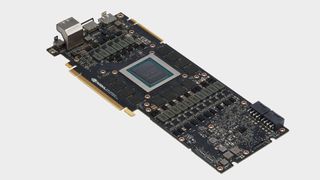New Nvidia Ampere GPU suggests the RTX 3090 rumour mill might actually be right
The 250W TDP of the new A100 PCIe card suggests the proposed 350W total board power of an RTX 3090 is highly likely.

We're still waiting for Nvidia Ampere GPUs to appear in GeForce clothing for our desktop PCs, but the green team has now released a version of its top GA100 graphics silicon that could actually function in your gaming PC. Kinda. I mean, it's not going to run Red Dead Redemption 2 at a thousand frames per second, but it sure will compute like a son of a gun.
The new Nvidia Ampere A100 PCIe (via ComputerBase) is a sleek-looking slice of silicon design that will drop into a PCIe motherboard slot, and would rather it was a PCIe 4.0 one too. Stick that in an AMD X570 and you'll have a mighty compute machine. You'll just need another video card in there to actually produce an output as this thing has no ports.
It also operates with a considerably lower TDP than the previously released Nvidia A100 for HGX, which uses the SXM board form factor. The first Ampere card has a TDP of 400W, while this PCIe version has a far more reasonable 250W.
It's still essentially rocking the same GA100 Ampere GPU, with the same HBM2 memory, an astounding level of bandwidth, and all kinds of floating point and integer smarts. In fact, despite dropping 150W of max TDP, Nvidia is reporting only a 10% drop in performance of 'top apps.'
I guess it's almost a desktop Max-Q design for Ampere.
Which is all very fascinating, but this is PC Gamer not Compute Nerd Monthly, so what in the name of Huang has this got to do with gaming? The most recent rumours have the suspected top GeForce Ampere cards hitting 350W of total board power (TBP), which initially seemed ludicrously high for a 7nm part, especially considering the TBP of the Turing generation is considerably lower.
That's slightly different to the thermal design point (TDP), which should be used in reference to the GPU itself, and how much power the attached cooler needs to dissipate. TBP, on the other hand, is classed as how much power the total graphics card will pull on its own. That's also known as total graphics power (TGP), but those terms are effectively interchangeable.
The biggest gaming news, reviews and hardware deals
Keep up to date with the most important stories and the best deals, as picked by the PC Gamer team.

Unfortunately TDP and TBP/TGP are often wrongly conflated. For example, the TDP of an Nvidia RTX 2080 is regularly given as 215W when that's actually what Nvidia rates as its TBP. The actual TDP of the RTX 2080 is far lower at 148W, with the delta between the two figures being made up by the power demands of the memory and the power circuitry.
That delta on the Turing cards is around 45%, where the TBP is 45% higher than the TDP. If that follows with Ampere the 350W and 320W TBP figures that have been rumoured for the initial three cards actually look about right.
If the GA100 GPU in PCIe trim has a 250W TDP it wouldn't be unreasonable to believe that a GA102 version, whether in Titan or RTX 3090 colours, with GDDR6/X attached to it instead of HBM2, would deliver a TBP around the 350W mark. The top GA102 TDP would then be around 240W, with the cut-down RTX 3080 potentially offering a TDP of around 220W.
And if that's the case we might see Nvidia going back to just using TDP to talk about its new graphics cards in marketing materials...

Dave has been gaming since the days of Zaxxon and Lady Bug on the Colecovision, and code books for the Commodore Vic 20 (Death Race 2000!). He built his first gaming PC at the tender age of 16, and finally finished bug-fixing the Cyrix-based system around a year later. When he dropped it out of the window. He first started writing for Official PlayStation Magazine and Xbox World many decades ago, then moved onto PC Format full-time, then PC Gamer, TechRadar, and T3 among others. Now he's back, writing about the nightmarish graphics card market, CPUs with more cores than sense, gaming laptops hotter than the sun, and SSDs more capacious than a Cybertruck.
Most Popular






